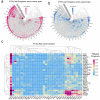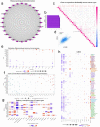A new prognostic risk model based on autophagy-related genes in kidney renal clear cell carcinoma
- PMID: 34636718
- PMCID: PMC8806698
- DOI: 10.1080/21655979.2021.1976050
A new prognostic risk model based on autophagy-related genes in kidney renal clear cell carcinoma
Abstract
This study aimed to explore the potential role of autophagy-related genes in kidney renal clear cell carcinoma (KIRC) and develop a new prognostic-related risk model. In our research, we used multiple bioinformatics methods to perform a pan-cancer analysis of the CNV, SNV, mRNA expression, and overall survival of autophagy-related genes, and displayed the results in the form of heat maps. We then performed cluster analysis and LASSO regression analysis on these autophagy-related genes in KIRC. In the cluster analysis, we successfully divided patients with KIRC into five clusters and found that there was a clear correlation between the classification and two clinicopathological features: tumor, and stage. In LASSO regression analysis, we used 13 genes to create a new prognostic-related risk model in KIRC. The model showed that the survival rate of patients with KIRC in the high-risk group was significantly lower than that in the low-risk group, and that there was a correlation between this grouping and the patients' metastasis, tumor, stage, grade, and fustat. The results of the ROC curve suggested that this model has good prediction accuracy. The results of multivariate Cox analysis show that the risk score of this model can be used as an independent risk factor for patients with KIRC. In summary, we believe that this research provides valuable data supporting future clinical treatment and scientific research.
Keywords: Autophagy; kidney renal clear cell carcinoma; nomogram; prognostic risk model; tcga.
Conflict of interest statement
The authors declare no potential conflicts of interest.
Figures







Similar articles
-
Development of a Novel Sphingolipid Signaling Pathway-Related Risk Assessment Model to Predict Prognosis in Kidney Renal Clear Cell Carcinoma.Front Cell Dev Biol. 2022 Jun 29;10:881490. doi: 10.3389/fcell.2022.881490. eCollection 2022. Front Cell Dev Biol. 2022. PMID: 35846357 Free PMC article.
-
Identification of small molecule drugs and development of a novel autophagy-related prognostic signature for kidney renal clear cell carcinoma.Cancer Med. 2020 Oct;9(19):7034-7051. doi: 10.1002/cam4.3367. Epub 2020 Aug 11. Cancer Med. 2020. PMID: 32780567 Free PMC article.
-
Construction and validation of an autophagy-related long noncoding RNA signature for prognosis prediction in kidney renal clear cell carcinoma patients.Cancer Med. 2021 Apr;10(7):2359-2369. doi: 10.1002/cam4.3820. Epub 2021 Mar 2. Cancer Med. 2021. PMID: 33650306 Free PMC article.
-
Construction autophagy-related prognostic risk signature combined with clinicopathological validation analysis for survival prediction of kidney renal papillary cell carcinoma patients.BMC Cancer. 2021 Apr 15;21(1):411. doi: 10.1186/s12885-021-08139-2. BMC Cancer. 2021. PMID: 33858375 Free PMC article.
-
Autophagy-related gene P4HB: a novel diagnosis and prognosis marker for kidney renal clear cell carcinoma.Aging (Albany NY). 2020 Jan 30;12(2):1828-1842. doi: 10.18632/aging.102715. Epub 2020 Jan 30. Aging (Albany NY). 2020. PMID: 32003756 Free PMC article.
Cited by
-
Development of a Novel Sphingolipid Signaling Pathway-Related Risk Assessment Model to Predict Prognosis in Kidney Renal Clear Cell Carcinoma.Front Cell Dev Biol. 2022 Jun 29;10:881490. doi: 10.3389/fcell.2022.881490. eCollection 2022. Front Cell Dev Biol. 2022. PMID: 35846357 Free PMC article.
-
Identification of a novel PANoptosis-related gene signature for predicting the prognosis in clear cell renal cell carcinoma.Medicine (Baltimore). 2024 Sep 27;103(39):e39874. doi: 10.1097/MD.0000000000039874. Medicine (Baltimore). 2024. PMID: 39331898 Free PMC article.
-
Identification of molecular characteristics of FUT8 and alteration of core fucosylation in kidney renal clear cell cancer.Aging (Albany NY). 2024 Jan 25;16(3):2299-2319. doi: 10.18632/aging.205482. Epub 2024 Jan 25. Aging (Albany NY). 2024. PMID: 38277230 Free PMC article.
-
The Role of ERBB Signaling Pathway-Related Genes in Kidney Renal Clear Cell Carcinoma and Establishing a Prognostic Risk Assessment Model for Patients.Front Genet. 2022 Jul 12;13:862210. doi: 10.3389/fgene.2022.862210. eCollection 2022. Front Genet. 2022. PMID: 35903358 Free PMC article.
-
Prognostic Signature and Therapeutic Value Based on Membrane Lipid Biosynthesis-Related Genes in Breast Cancer.J Oncol. 2022 Aug 25;2022:7204415. doi: 10.1155/2022/7204415. eCollection 2022. J Oncol. 2022. PMID: 36059802 Free PMC article.
References
-
- Levine B, Klionsky DJ.. Development by self-digestion: molecular mechanisms and biological functions of autophagy. Dev Cell. 2004;6(4):463–477. - PubMed
-
- Klionsky DJ. Autophagy: from phenomenology to molecular understanding in less than a decade. Nat Rev Mol Cell Biol. 2007;8(11):931–937. - PubMed
-
- Mizushima N, Yoshimori T, Ohsumi Y. The role of Atg proteins in autophagosome formation. Annu Rev Cell Dev Biol. 2011;27(1):107–132. - PubMed
-
- Mizushima N. Autophagy: process and function. Genes Dev. 2007;21(22):2861–2873. - PubMed
Publication types
MeSH terms
Substances
LinkOut - more resources
Full Text Sources
Other Literature Sources
Medical
